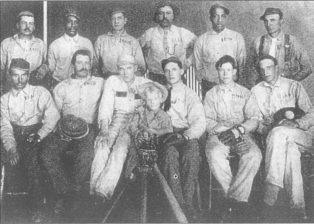Take a chance. Enter to Win a copy of the
Death Row All Stars: The Story of Baseball, Corruption, and Murder.

ostensibly to make sure his property was being maintained properly. He also would be able to monitor other activities at the prison, such as Warden Alston conferring with murderer George Saban on the baseball field. Gramm would have a firsthand look at the players who enjoyed fame of a sort— their names at one time or another resting on the tongues of men who had seen them operate; their faces known, having been posted in newspapers and on sheriffs’ boards along with the list of crimes they had committed.
On July 18, 1911, under a blue and cloudless sky, the murderers, burglars, rapists, and confidence men that made up the Death Row All Stars emerged quickly from the baselines of the baseball diamond at the penitentiary and spread across the practice field for their first game. Alston, Gramm, and a host of other prison officials, as well as inmates, were on hand to watch. Inmates craned their necks to see the action from their barred windows and cheered the players on as they whipped the ball from base to base. Warden Alston had supplied the team with gloves, bats, and uniforms, and the ball club look
It was evident after practicing with the other men on the team only a short while that Joseph Seng was an exceptional baseball player. News of the talented addition to Alston’s All Stars spread quickly throughout the area. Patrons who frequented the Turf Exchange, the Senate, the Elkhorn, and other watering holes in Rawlins, speculated on how well the team would do against more established ball clubs in the region. George Saban encouraged such talk whenever he made stops at the saloons as part of his duties transporting items to and from the prison accompanied by prison guard D. O. Johnson in the penitentiary wagon. Security was always lax where Saban was concerned. He came and went from tavern to tavern as he pleased and boasted about the baseball team he helped manage.
Betting on baseball was commonplace in 1911, regardless of its legality. Partnering with a drifter named George Streplis, a man who had been arrested in March 1911 in Wyoming and held over for trial on gambling charges, Saban had plans to capitalize on the trend of betting on baseball games by urging patrons at saloons in Rawlins to bet heavily on the Death Row All Stars. Any ideas Saban had about placing bets on the penitentiary ball club were tabled, however, until he knew how long Seng would be at the Rawlins facility. He didn’t want to gamble on the team if Seng wasn’t going to be at the prison long enough to play with the All Stars. An appeal of his sentence had been filed with the governor immediately; on June 15, 1911, Governor Carey responded favorably to the appeal, and, on July 18, 1911, the Chief Justice Board of the state Supreme Court granted a stay of execution in his case.
Regardless of the fact that his time as head of the prison lessee program was coming to an end, Otto Gramm believed he had some lingering influence at the facility. He did own all the equipment and material used to manufacture the brooms, and, as long as that was the case, he would insist on being a part of the business, visiting the penitentiary and played like professionals. There was no infighting, and players didn’t discuss the specifics of their criminal history with one another. The focus was the game.
The stories of the men who took to the field were varied. Shortstop Joseph Guzzardo had killed a woman in 1908 while shooting at a man who was threatening his life. Eugene Rowan, the first baseman, had been convicted of breaking and entering and attempted rape in Cheyenne. Right fielder and catcher James Powell had attacked a young woman. Team captain George Saban had pled guilty to three killings. And catcher and fielder Joseph Seng had been sentenced to death for the murder of a man in Uinta County.
Every time a player came to bat and slapped a ripping fastball on the nose for a solid hit to left field or someone snatched up a red-hot grounder and heaved it to the proper base to get an out, the All Stars forgot they were little more than caged creatures. Warden Alston and Saban stood on the baselines conferring on strategies of the game, discussing when a good bunt would beat a strong hit and how best to utilize each player. But the ever-watchful Gramm believed that their conversation went deeper than that. Prison guard D. O. Johnson had reported to Gramm that Saban was illegally betting on the All Stars’ games using money given to him by Warden Alston. Gramm relayed the information to Senator Francis Warren, who suspected the rumor might have a future and that Governor Carey, who had handpicked Warden Alston for the job, was also involved. Senator Warren once said of Governor Carey, “If I hadn’t known Carey from the time he stepped off the train in 1869, a green boy up to the present, and hadn’t figured inside of the inner circles so much with him in political affairs, he might possibly fool me once in a while, for he surely is the most monumental hypocrite, and the most infernal liar—when necessary—that God ever permitted to live.

To learn more about the inmates who played ball at the Crossbar Hotel read the
Death Row All Stars: The Story of Baseball, Corruption, and Murder.

